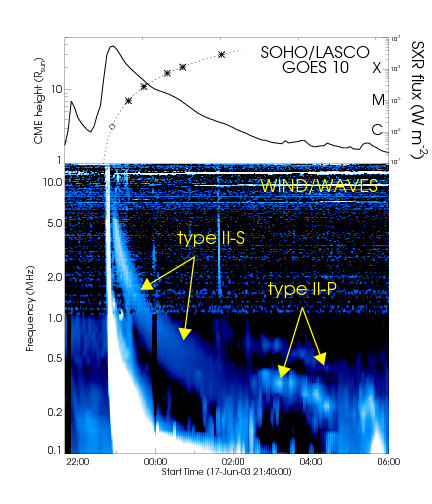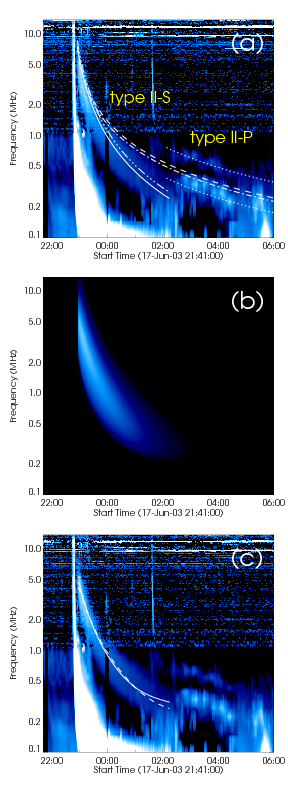Coronal and interplanetary (IP) type II radio emissions are widely believed to result from the interaction of a super-Alfvenic shock with the coronal and/or the interplanetary medium, producing plasma radiation at the fundamental and/or harmonic of the electron plasma frequency. In the case of coronal type II radio bursts, the nature of the shock driver remains controversial: flare blast waves, flare ejecta, and coronal mass ejections (CMEs) have all been considered. In contrast, it is generally accepted that shocks driven by fast CMEs are responsible for IP type II radio emission. Regardless of the driver, type II radio emission has long been used as a tracer of shocks in the corona and the interplanetary medium.
While the nature of the type II shock driver has been controversial, the assumption that type II radio emission is due to plasma emission is widely accepted. Recently, however, I analyzed a number of slow-drift radio bursts observed by the Wind/WAVES experiment that calls this basic assumption into question. A case study of one such event — a fast halo CME that occurred on 17-18 June 2003 — was published in the Astrophysical Journal, and is summarized here.
A slow-drift radio event
The slow-drift radio event on 17-18 June 2003 was classified as type II and, more particularly, as an “IP type II” event (Cane & Erickson, 2005). It was associated with a fast halo CME (observed by SOHO/LASCO, and listed in the CME Catalog) and a GOES M6.8 soft X-ray flare located at E55 S07. Figure 1 shows a dynamic spectrum of the event along with the height-time diagram of the associated CME and the GOES soft X-ray light curve. The CME shows little sign of acceleration or deceleration to an apparent height of ~30 solar radii. Its apparent speed on the sky plane is 1820 km/s whereas its deprojected speed is 2010 km/s.
The dynamic spectrum of the radio emission shows intense (~106 SFU) type III emission during the rise phase of the soft X-ray flare followed at 22:55 UT by faint, slow-drift emission that persists until about 02:30 UT on 18 June. At that time, a second type of slow-drift radio emission is evident, although it may appear as early as 01:30 UT. Here, two lanes of emission are present that are harmonically related and vary irregularly in time.
The first type of slow-drift emission, labeled type II-S, is very faint compared to the type III emission that precedes it, with a maximum flux density of only ~450 SFU. In contrast to most coronal and IP type II events, its emission varies smoothly and monotonically with time. Only a single lane of emission is present and, again in contrast to most coronal and IP type II emission, it is relatively broadband.
 Figure 1: Observational summary of radio and soft X-ray emission from the fast halo CME on 17 June 2003. The top panel shows the time variation of the GOES 1-8 Å soft X-ray flux (SXR, right-hand axis) and the apparent height of the associated CME as a function of time (asterisks), as measured by SOHO/LASCO (left-hand axis). The dashed line represents a linear fit to the CME data. The diamond symbol shows the inferred height of the CME at the time the type II-S event begins. The lower panel shows a calibrated, background-subtracted dynamic spectrum composed from Wind/WAVES RAD1 and RAD2 data. The type II-S event appears as a diffuse, slow-drift band following the type III radio bursts. The type II-P emission appears as a harmonic pair of narrow-band lanes following the type II-S event.
Figure 1: Observational summary of radio and soft X-ray emission from the fast halo CME on 17 June 2003. The top panel shows the time variation of the GOES 1-8 Å soft X-ray flux (SXR, right-hand axis) and the apparent height of the associated CME as a function of time (asterisks), as measured by SOHO/LASCO (left-hand axis). The dashed line represents a linear fit to the CME data. The diamond symbol shows the inferred height of the CME at the time the type II-S event begins. The lower panel shows a calibrated, background-subtracted dynamic spectrum composed from Wind/WAVES RAD1 and RAD2 data. The type II-S event appears as a diffuse, slow-drift band following the type III radio bursts. The type II-P emission appears as a harmonic pair of narrow-band lanes following the type II-S event.
Plasma radiation or something else?
If we suppose that the emission is due to plasma radiation from the foreshock of a shock driven by the fast CME, then it should vary in time as the square root of the electron number density in the foreshock region. I find that, while it is possible to match the start frequency of the IP type II-S with a density model that is modestly overdense relative to, e.g., a Saito density model, the radial dependence of the density is significantly steeper (r-3) than Saito (r-2) for the duration of the event. That is, rather unusual conditions are required in the solar wind to account for the type II-S emission in terms of shock-driven plasma radiation: it must be overdense relative to Saito close to the Sun, yet decline as r-3 over a radial range of some tens of solar radii. In contrast, the second type of slow-drift emission, which I refer to as type II-P, is entirely consistent with the plasma radiation hypothesis as long as the emission originates on the flank of the CME driver. Based on the flux density, bandwidth, morphology, and drift rate, I suggest that another emission mechanism may account for the observed emission from the type II-S: incoherent synchrotron radiation. I have constructed a simple model where the radio source is presumed to be associated with the fast halo CME. Briefly, the source is assumed to travel radially from the Sun with a speed similar to that of the associated CME, expanding linearly with time. The radial dependence of the magnetic field and the energy dependence of the emitting electrons are described by power laws. The ambient thermal density is described by a scaled Saito model. For a (deprojected) CME speed of 2010 km/s, a model spectrum can be synthesized that is very similar to the observed type-II S emission – in terms of the frequency drift rate, frequency bandwidth, and flux density – if the magnetic field is described by B = 3.0 r-1.65 G, and the index on the power-law distribution of electrons is delta = 5 (see more details in the paper).

Figure 2:
a) Comparison of the frequency drift rates expected from plasma radiation from a Saito et al. (1977) density model. The type II-S emission cannot simultaneously fit the start frequency and the frequency drift (dashed, dot-dash lines). However, the type II-P fundamental and harmonic emission is adequately fit (dotted lines) by the Saito et al. density model if the shock is on the flank of the CME. The type II-S can be approximately fit by density models that varies as r-3 (dots-dash line) or r-2.75 (solid line).
b) A simple synchrotron model of the type II-S event. See the ApJ paper for a detailed discussion of the model assumptions and parameters.
c) same as panel (a), but with plots of the frequency of the flux maximum at time t, resulting from the synchrotron models. The solid line uses the deprojected CME speed (2010 km/s) while the dashed line uses the projected speed (1820 km/s).
A synchrotron source and questions that follow
If synchrotron emission indeed plays a role in type II-S events then they are the result of a very different population of electrons conventionally assumed to be responsible for coronal and interplanetary type II events. Specifically, the energy of the emitting electrons ranges from several times 100 keV to several MeV, as opposed to <10 keV for the electrons driving the production of plasma radiation. A number of questions are immediately raised:
- Where is the source region of the type II-S relative to the fast CME?
- What is the source of the energetic electrons responsible for the synchrotron radiation?
- How are the electrons accelerated and transported?
The answers to these questions are presently unknown and await the careful identification and analysis of additional events observed by Wind and STEREO.
Based on a paper published recently (http://arxiv.org/abs/0704.3108) in the Astrophysical Journal, Vol. 665, pp. 805-812, by T. Bastian
